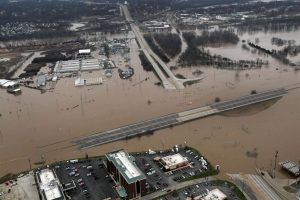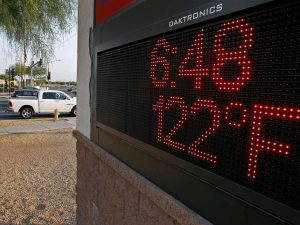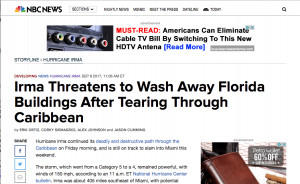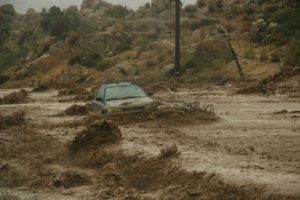- January 4, 2018
- Posted by: BlueSkies
- Categories: Extreme Weather, Forecasting, Forensic Meteorology
In forensic meteorology, we are often asked whether a given weather event was “foreseeable” – in other words, whether those impacted by or involved in the event should have or could have seen it coming.
Foreseeability generally has three components when considering weather events – climatology (what is “normal”), forecast (what is expected) and communication (whether those making decisions have access to crucial information).
Climatology
In many ways, climatological expectation is about timeline. Over a long enough timeline, even extreme weather events can be expected to occur.
That may sound counterintuitive, so let’s take a familiar example. If you flip a coin 20 times, what are the odds that you’ll get a run of 15 tails in a row? It doesn’t take a statistician to tell you those odds are pretty low.

But what if you flip the coin 200 times? 200 thousand times? As the number of total coin flips grows so too do the odds of seeing a run of 15 tails in a row, for no other reason than that there are more opportunities for it to occur. While a run of 15 tails would be extremely unusual within a trial of only 20 flips, it would normal and expected within a trial of 200 thousand flips. In other words, if you flip a coin 200 thousand times, you should expect to see a run of 15 tails somewhere within that trial. An event that is unusual within a short trial is actually expected within a longer one.
The same is true of extreme weather events. Take the “100-year flood”. What a meteorologist or hydrologist means when they say a “100-year flood” is an event that has a 1-in-100 chance of occurring in any given year. Over a long period of time, we would therefore expect to see such a flood occur, on average, about once every hundred years.
What “100-year flood” doesn’t mean is that a given location is “due” for such an event if the last one occurred more than 100 years ago or that it is “safe” if the last one occurred less than 100 years ago. Every year, the odds are the same: 1-in-100.
The expectation of a given event (from a statistical, climatological perspective) does not change based on past weather. A “100-year flood” is just as likely to occur next year as it was last year.
Go back to the coin flip example: If you have a correctly balanced coin, each flip carries 1-in-2 odds of showing tails. Even if you flip 10 tails in a row, the 11th flip carries the exact same odds of coming up tails: 1-in-2. It may feel like you’re “due” for heads after 10 tails in a row, but that’s psychology speaking not statistics.
What does change after an extreme weather event is knowledge among the affected population. Once an extreme event occurs, people know 1) that it can happen, and 2) what the impacts are. So while the occurrence of one extreme event does not shift the climatological expectation for when a similar event will recur (e.g. suffering through a “100-year flood” this year doesn’t mean you’re safe next year), it can impact the foreseeability of a similar event. After all, people know that it can happen because they’ve already seen it happen.
Forecast
The fact that a given weather event is within climatological expectations doesn’t necessarily make it foreseeable for the affected population. The weather-related impacts that population could reasonably have anticipated depend on a number of factors, including the weather forecast and impacts statements, as well as how that information was disseminated to the public and/or decision makers.

Weather forecasts, especially for major events, are generally quite good and have improved significantly over the past several decades. Anyone not living under a rock is unlikely to get surprised by a hurricane or a heat wave. Even the warning lead-time for tornadoes is up to an average of 13 minutes – plenty of time to take shelter if you get the warning. (We’ll return to that “if” in a moment.)
That said, sometimes meteorologists get it wrong. Small changes to atmospheric conditions can have major impacts on how a weather event evolves (that proverbial butterfly flapping its wings in Brazil). When there is significant uncertainty in a forecast, meteorologists try to express it. However, scientific uncertainty is a nuanced thing, and often the uncertainty statements are the first thing to get stripped for the headlines. So while meteorologists and decision makers with direct access to them may understand the forecast uncertainty and its implications, the general public may not.

Remember when Hurricane Irma was definitely going to wipe Miami off the map? Neither do I, because at no point during Irma’s evolution was an impact on the southeast FL coast a sure and immanent thing. But “Miami About to be Obliterated!” makes a far more clickable headline than “landfall near Miami looking possible, but storm could still swing further west or east”.
Which brings us to the final crucial piece in foreseeability: information access.
Communication
Even if a given weather event is within the climatological norms; even if the forecast is close to perfect, with uncertainty and potential impacts clearly and understandably communicated – even then a weather event can be “unforeseeable”.
If the people impacted by the weather event do not have access to or should not be reasonably expected to seek out forecast information, the event may not have been foreseeable. For example, every few years, hikers are injured or killed in the desert southwest when flash floods turn dusty arroyos into raging rivers.
- – Are afternoon thunderstorms during monsoon season climatologically normal? Yes.
- – Do forecasters generally recognize and issue warnings when it appears such storms may cause flash flooding? Yes.
- – Are the resulting flash floods foreseeable to the hikers 10 miles away from the storm and 30 miles from the nearest town? Maybe not.
That last question is arguably more difficult and is where forensic meteorology largely bows out of the discussion.

A forensic meteorologist can tell you whether a given event was climatologically unusual, whether the forecasts leading up to the event were accurate, and how that forecast information was disseminated.
But whether those who were impacted should have ultimately “seen it coming” is a more complex issue.
What if different forecasts disagreed? If a truly extreme event was forecasted, is it reasonable for people to think the forecast was exaggerated? What is reasonable ignorance or incredulity in this age of information-overload and often hyperbole? If someone has access to forecast information, should they be expected to actively seek it out? Should they be expected to act on it?
These are often the types of questions that arise in weather-related investigations and disputes. What starts out as a series of relatively straightforward meteorological questions ultimately winds into a complex web of human psychology and societal and cultural expectations.
The meteorological science is a crucial component of such investigations, but developing a rigorous and comprehensive understanding of the situation requires cross-disciplinary collaboration and communication. The weather is where the questions start, but not necessarily where they end.
If you are involved in a weather-related investigation and would like to discuss how a forensic meteorologist could support that work, please reach out to Blue Skies Meteorological Services for a free, no-obligation consultation.

